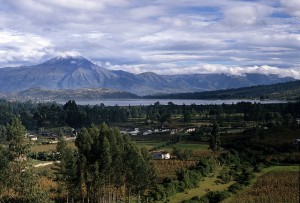Greg Gilliam is an expat who started his odyssey by driving through Central America on a extended vacation. He found his paradise when he eventually arrived at Canoa Ecuador on the Pacific coast, where he became an expat.
What he has done since then is nothing short of amazing. Putting his architectural design skills to work, he began eventually creating his own hotel, The Canoa Beach Hotel. The following is interview with him over email.

Photo Credit: Greg Gilliam
1. Why did you leave the U.S.?
I left the states just on a brief vacation and quickly discovered that I knew relatively very little about Latin America and its cultures. I could not even think of going back when I came to the end of the road in Panama and I was so determined to continue with my discovery of Latin America, that I hopped on a sailboat and headed for Ecuador.
Not long after I arrived in Ecuador, I found myself designing and building some really cool stuff and best of all, I was unchecked by the appraisal/refinance monster that rides herd over creativity in the U.S. Housing market.
Here, in Ecuador, I found I had complete freedom in design and for the first time in my life I was, and still am, really excited about designing and building.
2. What were some of your favorite stops on the way down?
There were many places on the drive which were very special; one was Colima, Mexico. The people in Colima are by far some of the most hospitable I have ever found in my travels. They made it a great trip.
My brother and I were camped for a few weeks at an old airport turned into a dragstrip. We decided to have a little party for all the friends we had made while in Colima and invited everyone we could get in contact with and told them to come to the airport, where I thought we’d drink a few beers and eat a few snacks while we said our goodbyes.
Two hours passed and no one had shown up for our party and my brother and I were beginning to wonder what had went wrong, when suddenly our party guests arrived with what looked like the whole town in tow. I mean at least 100 people, all bringing food and drinks.
It took us another two more days to actually be able to leave Colima.
3. Where did you end up at the end of your drive?
Panama is another of the places with many nice people and a culture that has been created by the canal. Panamanians are easily some of the most resourceful people you will ever meet. I think they can tackle just about anything and everything.
In Panama City there is a very strong international culture, which lies only a few miles from a beautiful rural culture full of hardworking respectful people.
We were politely surprised once, when in gringo Spanish and really bad charades, hoping to get a band-aid, the guy behind the counter at a country tienda said in perfect English “You boys ain’t from around here are ya?” and then proceeded to wow us with tales of taxi driving in New York City and how this little store was what he wanted to do in his retirement.

Photo Credit: Canoa Beach Hotel
4. What are you doing now?
I became involved with a local architect, a great one, named Antonio Naranjo, who along with Enne Arquitectos have founded the green building council in Ecuador.
Once again, I am totally loving life. We just finished designing and building the Canoa Beach Hotel.
We are excited for the way it has become a haven of relaxation for my building clients, and as a popular spot for tourists. At Canoa Beach Hotel guests can experience firsthand my take on sustainable architecture. It is also a great springboard for our new project, , where we are building condominiums on the same beach, Senderos.
It is a novel project in design and functionality, while keeping the same organic randomness that I believe comforts us so much about nature.

Photo Credit: Greg Gilian
5. What advice can you give someone who wants to build a dream home in Ecuador or even Canoa Ecuador?
If you want to build a dream home in Ecuador, I highly recommend first finding your dream location, and there are plenty. But before you leap into that place, rent in the area you like, and make sure you are still enamored with it 3 months later.
There are many qualified architects and builders in Ecuador, but due diligence is key to your success, so call their references and look at their projects, especially the older ones.
Most importantly really collaborate with your architect and create something that is really you, this is your dream home, to me, building is all about making your personal statement. This is sorta how I roll.
I love Ecuador. For many reasons, but it is hard to pick just one. The Ecuadorian people are great, especially if you take time to learn the language and the culture, but don’t confine your experience to a few expat locations.
In Ecuador you certainly will never be bored, but and as anywhere in the world, there are stories of bad deals, crime, and any number of the negative behaviors that trouble every place on the planet, so be smart and respectful, and you just might find that Ecuador is a dream place to live.
Lee Zelter knows Boquete, Panama. It’s almost as if it’s in his blood. His blog Boquete Guide is a must read for those who are considering the move to Boquete or for those who have already made the jump.
Viva Tropical took a moment with Lee to dig a bit deeper into his reasons for calling Panama home for the past 7 years. His answers might just surprise you.

Photo Credit: Sky and Zak
Why did you choose to move to Panama and specifically Boquete?
We researched for several years while waiting for our youngest to finish high school. We visited Europe, Mexico, Costa Rica and last Panama. We decided on Panama for several reasons.
Cost of living was lower than Europe and the U.S. Mexico was getting too violent. Costa Rica was a boat we missed and crime was heading up as an anti-gringo attitude was developing.
The pluses of Panama were that in a time when the dollar was falling against other currencies, Panama used dollars so we would not be hurt by varying exchange rates. Panama has a hundred years of U.S. involvement and to Panamanians Americans are nothing new.
Gringo is a description not a swear word here. We loved the temperate climate and relative isolation of Boquete. It was time to leave city life and try something new.
There was a significant English-speaking international community in Boquete which made for an easy integration. My wife lasted 18 months, it was too much of a change for her. I stayed and love it here.
How long have you lived there?
Seven years in August 2013
Where where you living previously?
Tucson, AZ, U.S.
What do you do with your time?
I work online, write online and play online. I also travel extensively in South and Central America.
What surprised you when you first came to Boquete/Panama?
How many shades of green exist!
What advice can you give someone who is thinking about moving to Boquete/Panama?
Learn Spanish first, leave your preconceived attitudes at home and do not check your brains at the airport. This is a different world.
Anything else you’d like to say?
I have much more about the entire experience at this link. The entire Panamania series reflects the move, transition and experience.
The Costa Rica 3 Count, where we bring you 3 Costa Rica stories that you shouldn’t miss.

Photo Credit: Berny Mills
1. Border Crossing Mistakes (and Why They Make You Look Dumb)
Walking across a land border seems like you’re entering into a no-man’s-land of confusion. At an airport, VIPs enter and zoom through in blackened sedans, but when you walk across a frontier, especially in a developing country, you get a window into how ordinary people and traders travel. Such is the case when crossing on foot from Costa Rica to Nicaragua.
2. Costa Rica Hotels are King in Sustainability
Costa Rica is leading a growing trend of low-carbon to no-carbon footprint hotels. Currently there are 29 hotels labeled as “five leaves,” Costa Rica’s distinction of sustainability, which means these hotels ensure their operations are at a near zero environmental impact.
3. You Don’t Have to Give Up Your Golf Game When Moving to Costa Rica
If you want to become an expat in Central America, rejoice, you don’t give up your golf game when you move. Golf is blossoming in such far-flung, but expat-friendly, locations as Nicaragua, Honduras, and Costa Rica.

Photo: Viva Team
Buying property in Panama can be a cumbersome task. The good news is that, when dealing with experienced professionals you can trust, it doesn’t have to be.
While some investors and expats choose to learn all the ins and outs of the process, many see no need to reinvent the wheel when there are others who do this kind of thing every day and are much better equipped to navigate the system.
As that latter group has learned, buying property in Panama isn’t about what you know. It’s who you know. And it is absolutely essential to work with a team you can trust.
Step 1: Narrow Down Your Search.
Start looking for properties. Take into consideration the type of climate, community, and culture that you’re looking for. Whatever you’re into, Panama has an area that can accommodate your interests.
Once you’ve chosen your area, find a few listings that appeal to you and contact the seller, developer, or listing agent. You can start by emailing them to see if you get a response. If it’s a company who’s selling, research them online. Try to verify whether they’re legit.
Once you’ve weeded out any bogus or unreliable sources, contact the sellers of your top candidates by phone to feel them out a little more. Treat this more like an interview than just a cursory fact-finding mission. You want to make sure that everything they’re telling you about the property and the process corresponds with what you know to be true.
If there are any red flags that pop up in your dealings with the seller, walk away. Don’t waste your time and effort trying to work with someone who isn’t cooperative or trustworthy.
Step 2: Build Your Team.
Working with a team of reputable professionals is the key that can make or break your property-buying experience. However you’ll be relieved to know that, having successfully weeded out any questionable sellers, you’re well on your way to building a team you can trust to work in your best interests and get the job done.
Like-minded folks often tend to run in the same circles. So if your real estate agent is trustworthy, then you can usually trust others in his network. (Note that the opposite is also true. If a seller gives you reason to doubt him, run–don’t walk–away from the rest of his cronies as well.)
While you should certainly do your part to double check their reputation, it’s a good idea to ask the real estate agent or property developer for recommendations on attorneys, escrow companies, surveyors, or other professionals you’ll need. This can save you a wealth of time and energy when trying to select these professionals from thousands of miles away.
So it’s important in this stage to evaluate whoever you’re going to be working with. This means real estate agents, attorneys, sellers, etc.
Step 3: Come See for Yourself.
The final step before pulling the trigger is to take a trip to see the property (or properties, if you’re considering more than one) for yourself. Make arrangements to meet with the seller (or sellers), and see if you can go ahead and plan a meeting with the attorney you’ve selected to get the ball rolling.
Keep in mind that, depending on the seller or company you’re dealing with, you may be responsible for arranging for all your own travel, especially once you’re on the ground in Panama. And we all know nothing ever goes wrong when traveling internationally, right? Wrong.
Things happen. Flights get delayed. Cell phone service is spotty. Make sure those you’ll be meeting know how to reach you and that you know where to find them as well. Get their office number, cell phone number, home phone number, physical address, email address, and every other form of contact you can think of. And always have a back-up plan.
Once you’ve connected with everyone, sit back and relax and enjoy the beautiful scenery. Make sure to allow plenty of time to do everything you need to do. Depending on the remoteness of the properties you’re considering, you may be traveling by boat, or horseback, or even on foot. Don’t expect to be hopping in a car with a realtor and seeing eight or nine properties in an afternoon.
Step 4: Let Your Team Get to Work.
Once you’ve selected your property, this is where the right team will really start firing on all cylinders. Your attorney will start by drafting up a contract to buy and issuing a deposit to the seller. The contract will spell out all the contingencies that must be met.
The attorney will then research the title or rights, liens, and any other legal issues with the property. Hopefully you’ll find everything in order once your team has done their homework on the property.
If everything’s in the clear, your attorney will obtain a bill of sale and have the title transfer completed. After that it’s time to disburse the funds, which you’ll need to have wired to a Panamanian bank.
That’s it. It’s that simple. At least, it can be. By delegating responsibility to a few trusted individuals, the process of buying property in Panama can be virtually hassle-free on your part. In fact, if you’ve arranged everything properly with your attorney, you might not even have to show up for the closing.
Imagine that. You take a trip to Panama to look at a property you’re considering, and the next time you return…it’s yours.

Photo: EcoCircucitos
If you’re looking to make Panama your home, whether for a few years or a lifetime, there are a variety of visa options available to you. Panama is very friendly to foreigners and is continually opening its doors even wider to those who want to move there for practically any reason. We’ve compiled some more information about the various visa options, their requirements, and the process of obtaining them. However, because the country is making such large strides to become even more open to immigrants, the laws are frequently changing.
The good news is that the process is only getting easier. The bad news is that it can take some serious digging to find information that is current. If you’re serious about starting the process now, a reputable Panamanian lawyer with immigration experience can drastically cut down on the time and headaches associated with the process. In the meantime, check back often for updates on recent decrees and resolutions.
The Application Process
The requirements, timelines, and procedures vary greatly from one visa program to the next (yet another good reason to work with someone who’s familiar with them all). However, a few key points are central to the process as a whole. Documentation will be required to show proof of all requirements set forth by the specific visas. For instance, a letter from a bank will be required to verify solvency where needed, and a promise of work contract will be needed to show proof of employment.
These documents should all be clean and current and bear the proper authentication by an attorney or Apostille, which is similar to a notary public. All passports should be current with at least a year (or more) remaining before their expiration date.
For dependents, you will need to obtain current copies of marriage and birth certificates. A current police record from your country of residence is generally required. You will also need to be examined by a Panamanian doctor to receive a certificate stating that you are free of disease and in good mental and physical health.
While some steps in the process require you to be physically present, an attorney can handle many of the tasks with a signed Power of Attorney.
The Visa and Residency Options and Requirements
Tourist Pensioner Visa
One of the most popular and beneficial visas offered by the Panamanian government is the Tourist Pensioner Visa. Available to those who can show a minimum monthly income of $1,000 from a verifiable source, such as a pension, this visa has no expiration date. It is also exempt to any future changes in the law, so current holders are grandfathered in under the program.
Proof of income is required and has to be provided on a yearly basis to show that you are still receiving a pension. While this visa does not offer a path to citizenship, it does provide a number of benefits that are unmatched by any of Panama’s other visas, or those of any other country.
However, don’t worry about missing out if you enter the country by some other means. While these benefits are provided automatically to anyone on the Tourist Pensioner Visa, they are also available to anyone over the age of 60 (55 for women) and to others on a case-by-case basis. Here are some of the highlights:
-
50% off entertainment (e.g. movies, theaters, sporting events, etc.)
-
30-50% off hotels
-
30% off public transportation (e.g. boats, buses, and trains)
-
25% off airline tickets
-
25% off utilities
-
15-25% off restaurants
-
15% off medical services (exclusive of procedures covered by insurance)
-
Tax-free importation of household goods (up to $10,000)
-
Tax-free importation or purchase of a new car every two years
Private Income Retiree Visa
For those who might have received a pension as a lump sum, the Private Income Retiree Visa is an excellent option. To qualify for this visa you’ll need to invest enough money in a 5-year certificate of deposit (CD) in the National Bank of Panama to generate $2,000 per month.
The visa is renewable every five years, provided that the CD is also renewed. Holders of this visa are granted a Panamanian passport, but no direct path to citizenship. Private income retirees can also import their household goods and a vehicle every two years with no taxes, just like tourist pensioners.

Photo: Rita Willart
Person of Means Visa
The Person of Means Visa requires a 3-year fixed-term deposit of at least $300,000 in a Panamanian bank. A mortgage-free real estate investment of the same amount (or a combination of the two) will also qualify you for this visa. Unlike the previous visas, this option can lead to permanent citizenship after one initial renewal, so long as your financial situation remains secure. It also offers the ability to become a Panamanian citizen if you choose.
Investor Visa
Panama is also friendly to those who wish to do business or invest in the country. With a $160,000 initial investment and the hiring of five full-time Panamanian employees, you can qualify for an Investor Visa. This visa is good for a period of two years.
While it can lead to permanent residency, it must first be renewed three times. Once they become permanent residents, holders of the Investor Visa can also apply for Panamanian nationality.
This is an older visa and for most people there are better options.
Permanent Residency for Nationals of Countries Friendly to Panama
One of the most recent additions to Panama’s residency options, and the one with the longest name, is the Permanent Residency for Nationals of Countries Friendly to Panama option.
With requirements that are much more attainable than many of the other visa options, this program offers immediate residency.
In addition to skipping all the steps of obtaining (and renewing) a visa, it offers another benefit that many of the others lack: It gives you the option to work. Born out of an acute need for skilled labor, due to the country’s huge economic boom, this program requires a mere $5,000 deposit in a Panamanian bank (plus $2,000 for each dependent). In addition applicants must show proof of one of the following:
-
Investment in Panamanian real estate
-
Ownership in a Panamanian corporation
-
Employment by a Panamanian business
This program, introduced in the form of Decree 343, is offered to residents of 47 countries that have been identified as being “friendly” to Panama and is available to you, your spouse, children under 18 (or between the ages of 18 and 25 if they’re students), and children of any age with disabilities.
No renewals are needed since this program grants immediate residency, and those who take advantage of this option are also able to apply for citizenship.
Given the simplicity of opening a Panama Corporation or investment in Panama real estate, this visa has become one of the most popular.
Accelerated Permanent Residency for Professionals
Another piece of legislation that’s hot off the presses is Decree 229, which changes the amount of time a person must work in Panama before becoming a permanent resident. Historically, those in Panama on a work permit could apply for permanent residency after a period of seven years.
The recent bill, which applies to those working in a professional capacity, reduces it to two. The decree applies not only to those who will seek employment in Panama in the future, but to those already working there as well.
Forestry Investor Visa
Designed to promote the production and preservation of teak, the Forestry Investor Visa offers both a small and large option. Small forestry investors will need a $60,000 minimum investment.
This visa is only temporary and must be renewed every year for six years. On the seventh renewal, you can apply for permanent residency.
The Large Forestry Investor Visa, which requires an $80,000 investment, is good for two years initially. After that period of time, you can apply for permanent residency. Five years after obtaining residency, you can also apply for citizenship.
Other Visas
Keep in mind that, while these visa and residency options are the most common, this list isn’t exhaustive. There are other solutions available for individuals such as agriculture investors, those doing business in tax-free zones, temporary workers, and more. If you want to call this Central American destination your home, there is almost certainly a way to make that happen.

“Carumba!” the driver shouted. What was he going on about? Oh, there it is. The spluttering of the outboard engine. And then, no more spluttering. And no more engine. There we were, in the middle of the ocean in a dug-out canoe. With no engine.
“Carumba!” the driver said again. I wanted to say something else. You see, I had a plan. I needed to check out the progress on our island project and go to the bank that Saturday. So the business man in me worked it out logically. The trip to the island itself should take three hours, in an ideal, non-Central-American world.
I multiplied that by three (which I like to call the Cultural Harmonizer and it goes something like this: for every unit of time you expect to complete a task, multiply that by at least three and harmony will follow. Note: works in most countries). Nine hours should see me on and off the island leaving plenty of time to make a bank deposit before it closes. Right? Wrong. Wrong wrong wrong.
Culture, you see, makes all the difference. In arranging my trip to the island, I booked this boat with a picture of what I thought was clear and specific language. I asked for a fast boat big enough for the driver, a worker, and me. I got a dug-out canoe with a five horsepower engine. And now that five horsepower was zero. And we were floating backwards. Even though the boat trip on the way there had taken an hour instead of the 18 minutes as I’d expected, I wasn’t worried; according to my skillful Cultural Harmonizer calculation… We still had plenty of time for me to complete my objectives.
So while the driver was pulling off the duct tape from the engine, doing something that looked like a French plait with the wires, and occasionally scolding the rusty engine with a slap from his palm, I went to work. I went to work looking for the paddle in our tiny canoe. Turns out, that stick underneath the mound of a fishing net which I was using as a seat was the paddle, really? There is no “real” paddle? No problem, I thought. I’ve done plenty of paddling. Let’s try and figure out which end is which and off we go.
The thing was insanely heavy, maybe 50 lbs., and didn’t have a blade or any paddle shape, let alone a handle. After an hour of maneuvering this pole, my arms were cramped and against my better judgment, I admitted defeat. There was no way we were going to make it in time. Our boat was literally moving backward down the mangroves with the outgoing tide. The Cultural Harmonizer theory needed to be adjusted, it is not an exact science, but it appears it can be modified for any country. I missed the bank that day, and received several concerned calls after missing payroll. The businessman within me learned a lot from these types of experiences that always seem to accompany expat life.
I realized that I am the stranger in a strange land. Especially when you’re dealing with a culture so different to your own where fast means five horsepower, and boat means hollowed out log. If you are new to a country, using this calculation can be very helpful when managing your stress levels; though it might take a bit of time to learn how to calibrate, it can be a very handy tool. The culture in any given place has lots of momentum; notice how it works, then do what you do. Carumba!
If you’re hoping to retire to a beach haven overseas, may we suggest Panama? The Latin American country has a great deal of culture to offer, as well as beautiful scenery and fabulous weather. And the Panama beaches are an important part of the package.
Panama has many draws as an overseas retirement location, including vibrant communities, great quality inexpensive housing, and the beaches are some of the best. In fact, one of the best things about the country is that it has beaches leading onto two oceans: the Pacific and the Caribbean. In fact, Panama has over 1,500 miles of coastline!
Panama Beaches
In the past, Panama’s beaches have often been overlooked. Many of them are very rural and remote, and they haven’t typically been popular tourist destinations. However, there are some absolutely gorgeous areas of coastline in the country, and we don’t think that you should overlook them.
If you’re thinking about visiting or retiring to Panama, take a look at these top five beach areas in the country.
Coronado

Coronado Panama
Set only an hour away from Panama City, Coronado is a beach town that is well-loved by expats and Panamanians alike. The beaches themselves are an impressive site to behold. The beaches in this area have fantastic black and white sand, and are great fun to visit.
Away from the beach, the town of Coronado also has a range of leisure facilities including bars, restaurants, shops and a plaza area. This is a very popular area, and has a great expat community. This area is very different from the rest of the beach areas on the list: purely because of how developed it is. Coronado is the destination for you if you want to be able to shop in an American-style grocery store and meet up with friends for a nearby round of golf.
Boca Chica

Photo by Boca Chica Island
The Boca Chica area is wonderful if you’re looking for a rural, romantic spot to spend time with a loved one. The landscape here is made up of hills, valleys, and banana plantations. It also has a perfectly tropical climate. In the past, this was a very remote area, but it is fast becoming the next up and coming spot. The new airport in nearby David will soon be accommodating direct flights to the United States and Canada, which will make traveling here very easy.
The beaches in Boca Chica benefit from fine sand, dark beautiful water, and a quiet, peaceful atmosphere. Factor in the Chiriqui Marine Park, and the coast at Boca Chica is very attractive.
Bocas Del Toro

Bocas Del Toro is an area that’s made up of six islands, along with a number of uninhabited islets. It’s a beautiful part of the country, and is described by Conde Nast as “the Caribbean that time forgot.”
This area is popular with tourists and expats for many reasons. It has a great community, and is also home to some of the most typically beautiful beaches in the whole of Panama.
Here, you can expect to see flawless white sandy beaches and clear, turquoise water. Because of this, the beaches in this area are particularly popular snorkelling destinations.
Santa Catalina

The Lonely Planet has reported that Santa Catalina has the potential to be the next great Central American beach destination.
This laid-back town is mainly populated by laid-back Panamanian fishermen, but it does have a huge draw for tourists and expats alike: great surf! The beaches of Santa Catalina offer incredible surfing opportunities. Because of this, the town is growing, and is developing more and more facilities for expats.
Because of the relaxed atmosphere of the town, it also has a growing reputation for having a healthy attitude. There’s a real focus in the town on healthy food, as well as yoga. Santa Catalina is one of the few places in Panama with this sort of vibe.
Pedasi

Pedasi is a small town set in the outback of Panama. It’s a relaxed, low-key place with a rich history of folklore. If you visit the town, you can expect to be greeted by friendly residents, great food, and maybe even a beach party or two. There’s also something a little out of the ordinary waiting for you at Pedasi. In this area, some of the beaches feature beautiful lava covered sand.
But it’s not all quiet here. There are also a great deal of sports opportunities to choose from. Whether you’re into surfing, scuba diving, sports fishing, or horseback riding, you’ll find something to enjoy in the area.
The one downside of Pedasi is that property prices are quite high here compared to other rural areas with limited services.
Is One of these Panama Beach Areas Right for You?
Panama is a beautiful country that offers a lot more value for money than other more typical holiday or retirement destinations. It’s an inexpensive place to live, and this is true even in some of the more popular coastal areas.
If you’re looking for the ideal beach destination, to visit or even to retire to, one of these five areas might be the one for you.
Roatan, one of the Bay Islands in Honduras, just may be the world’s best island for expats.
1. Roatan is near-perfect island living.
Roatan’s growing expat community is now supporting many modern conveniences along with almost everything you can buy at home, and some that you can’t, like a never-ending vista.

Photo Credit: J Hound
2. Here, you can take up a new hobby.
The water is clear and warm and the beaches are white-sand. The world’s second largest coral reef lies just offshore, making the Bay Islands a favorite with divers.
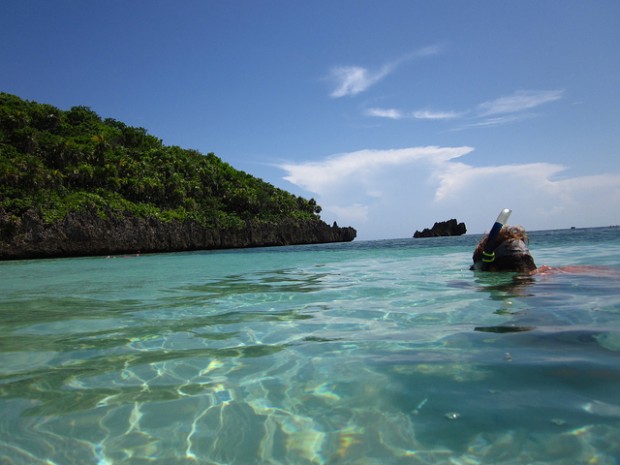
Photo Credit: Alex in Wanderland
3. Even make a few new aquatic friends.
Nature abounds in the Bay Islands; from ziplines to hands-on dolphin encounters, Roatan holds endless possibilities for making new friends.
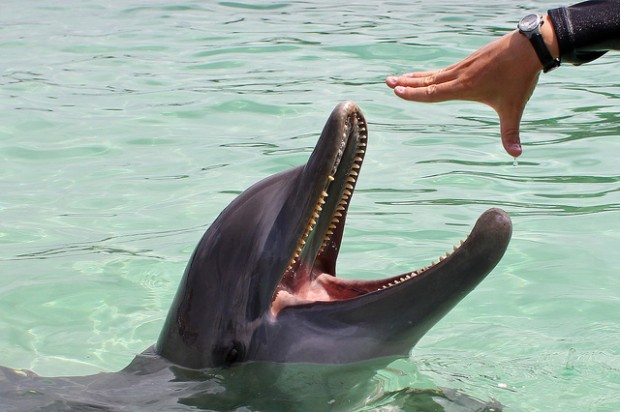
Photo Credit: Dolphin Encounter
4. You are encouraged to kick back and soak up the view.
Roatan is said to be where white sand meets clear, turquoise water on some of the world’s best beaches.

Photo Credit: P. Cheng
5. Without a doubt, life in Roatan might just be like an endless vacation.
Life is simpler and your needs are less. The price of U.S. goods is higher as you might expect on an island, but local goods are quite inexpensive and you will find they meet most of your needs.
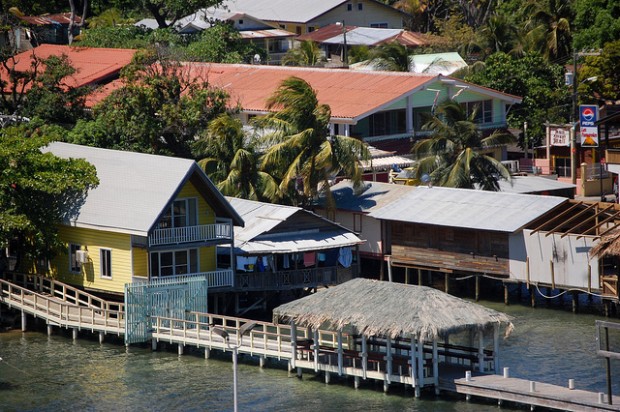
Photo Credit: P. Cheng
Have a favorite reason why you call Roatan home? Let us know!
When you scout properties for a living, you never know where you will find yourself. The chilly peaks of the Andes Mountains, the sweltering jungles of Costa Rica, or the tropical islands of Panama. What you can count on is the unpredictable; I have got my car stuck in a river, had engine failure while out at sea, and experienced short horseback rides that turn into all day affairs. Whatever the situation, the last thing you need is unreliable gear.
Here’s a list of the gear I’ve found absolutely invaluable during my time in Central America and beyond.
1. Go Pro Camera
Bombproof, this camera is super tough and when you purchase some of the accessories like the waterproof case it becomes a tough multi-functional tool. You can use it on a spear fishing trip or strap it to a helicopter to get a bird’s eye view of a real estate project. We attached two of them to our car on a scouting trip to Ecuador and shot 40 hours of footage.
Go Pro’s Hero cam is efficient and a real workhorse. The downside is that it can be difficult to figure out their two button system for commands and there is no way of seeing what you are currently shooting; battery life is not the best either, but the benefits outweigh the limitations. Note: I have not tested the Go Pro 3 yet, so usability could be improved in the new model.

Photo Credit: GoPro by Hero
2. Canon 7D L Series 24mm-105mm and Lens
Great images when coupled with this handy wide angle lens. Even with the crop factor, because of the smaller sensor, I can get the images we need for any use. The video is also good and has influenced my shooting style by allowing me to get images and video clips quickly. The body is tough; from rain, to mud, to bumps, the camera still works flawlessly.
I like to be as light as possible when I am out scouting and exploring; I am not a dedicated photographer, but we need good pictures, so the zoom lens works perfectly for me.

Photo Credit: Faran Grakthaia via Flickr
3. Pants
Gi III. My favorite pants by far, when you are scouting you are walking through jungles, cow fields, rivers, beaches, etc. These pants can get wet, are tough, and dry quickly. It’s important to be comfortable when you are hiking in the jungle all day looking at a 500 acre farm. When your day consists of riding a horse, hiking mountains, crossing rivers, and hopping barbed wire fences, you don’t want to slowed down by being uncomfortable. The adjustable belt allows you change up tension as necessary, like when you have batteries and lens caps in your pockets.
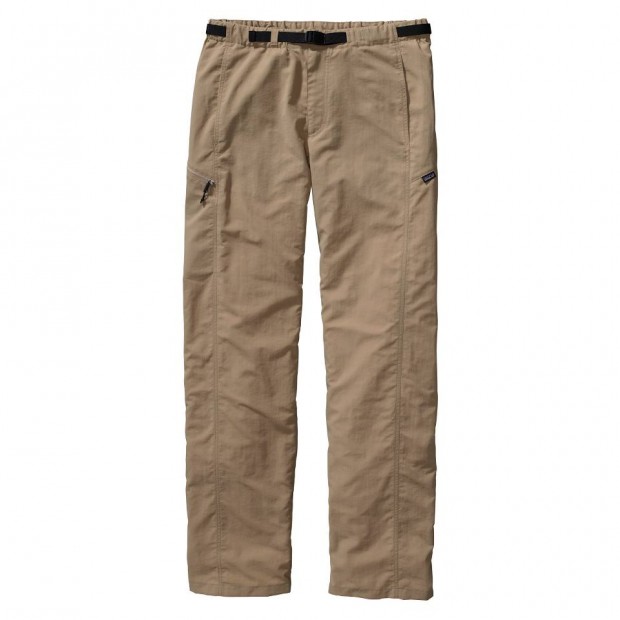
Photo Credit: Patagonia
4. Shirt
I borrowed one of these shirts and it showed me what I had been missing. Usually I rely on the Exofficio brand for my shirts; they are great, but they are also very hot. The Patagonia version has short sleeves which is not very good when you’re stuck in the sun on small boat scouting a coastline. Any exposed skin gets singed by the hot sun. Also when you are in the jungle, bugs can feast on you with short sleeves.
Bonus: These shirts and the pants are easy to clean with a water source and Dr. Bonners soap. When you are on the road for 14 days in a row it can be hard to do laundry; no problem if you have a sink and soap.

Photo Credit: Patagonia
5. Shoes
I have gone through so many pairs of shoes that I don’t have a specific recommendation, the truth is I haven’t yet found a shoe that blends breathe-ability with toughness. Shoes get shredded in this environment from the humidity to barbed wire fences, to trees like the Achote that are literally barbed.
I do have a good piece of advice, don’t get any thing that is open, like the currently popular Amphibious models. If you are scouting land you will be walking through the jungle and or cow fields, both of which have ants, and if you step on an ants’ nest with open shoes you will be very sorry. Also ticks and other jungle critters can get you. If you are just vacationing and not jungle trekking the amphibious models are a great choice.

Photo Credit: Jungle Boots.org
6. Flops
After a tough day in the jungle, I usually take off my boots and socks and switch up to my favorite flip flops. I have owned so many pairs of these it’s amazing. Rainbow have consistently proven to be the longest lasting in this environment, but they get really slippery when it rains. This is treacherous in rainy season, they feel like you are walking on grease, making it very difficult to not slide around, not to mention dangerous.
I recently picked up a pair of the hemp rainbow sandals (I know they are hippy dippy) and have been really happy. They have a layer of hemp across the footbed of the shoe, which helps tremendously with water, plus they have been built by Rainbow which means they are solid and have a great warranty.
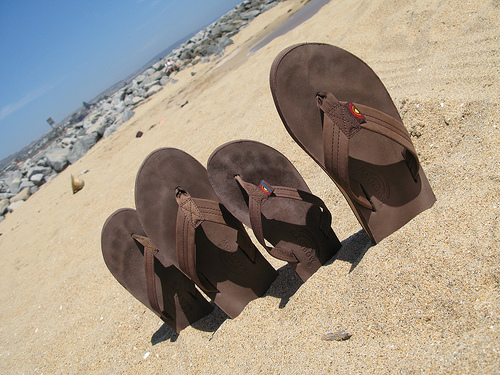
Photo Credit: Flickr
7. Laptop
Apple Macbook Pro 15 inch. Great computer, but not really very tough. I am constantly fixing things on my laptop; I am not sure if it has trouble with the dusty environment I live in or bumps on the road, or humidity, all of which are bad for laptops. I think the quality of Apple products has been on a downward slide. I am currently trying to get out of the Apple eco system, but have not found a worthy alternative just yet.

Photo Credit: Flickr
8. Phone Nexus 4
My view on technology right now is that I don’t want to spend a bunch of money on hardware. The reason is, things happen, freak rain storms drown your stuff, things fall out of your bag, humidity, dirty hands, dirty power, etc. Nothing really lasts in this region so why spend money on it.
The Nexus 4 is perfect for here in that it is cheap and functional, now if I can get the same value from my laptop. GPS works well enough to mark trails, roads, boundary lines, pretty amazing actually.

Photo Credit: Nexus
9. Backpack
The Osprey Atmos 50 is a great pack, I will probably get another one when this one finally dies. Throwing it into the storage compartment under the bus, bouncing around in the back of the pickup, or just standing in the corner of the Mango Bay Villa, this pack handles it all.
It isn’t waterproof, but other than that, the pocket arrangement, main compartments and materials are smartly designed to create a quality reliable pack. I usually don’t hike much with these packs, I use it more for short little trips, and when used in this capacity it’s really comfortable.
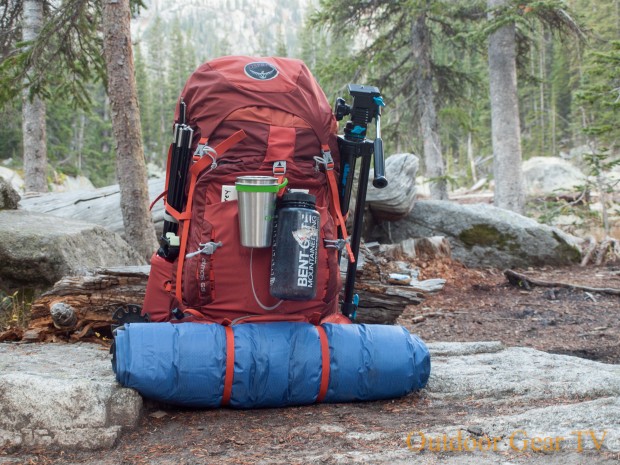
Photo Credit: Osprey
10. Day Pack
I have had this pack for 3 years, which is amazing, I use it all the time and everything has worked well until recently. The bottom zipper has become corroded, the weather in this region is brutal on zippers. I have lost several pair of surf trunks due to zipper corrosion. The layout of the pack for carrying a SLR, laptop, phone, and all the necessary accessories works really well for me. The internal frame also helps keep the load balanced and feel solid. I sprung for waterproof bags that I keep in the pack in case I get surprised by the rain, more cost-efficient than buying waterproof packs.

Photo Credit: Campist
Do you have a favorite gear item? Leave us a comment below so we can add it to our list.
The Belize 3 Count, where we bring you 3 Belize stories that you shouldn’t miss.

Photo Credit: Belize’s Ambergris Caye voted best island by TripAdvisor.
1. The Best Island in the World (According to TripAdvisor)
First up: Belize’s Ambergris Caye has been voted the “world’s best island” by contributors to TripAdvisor, taking the top spot from more well-known island paradises such as Bora Bora and Thailand’s Koh Tao and cementing Belize’s reputation as one of the world’s top travel destinations.
2. Belize: Where the Most Back-to-Basic Expats Call Home
Next up: Belize has a history of freedom-seekers taking up residence in this tiny nation. From pirates to Mennonites, people came looking for a place where they could live without anyone bothering them. Today a new population of freedom-seekers is finding its way to these shores — foreign retirees and others in search of a place to start over.
3.How Mitt Romney Helped Belize Remain a Top Tax Haven
Finally: After enjoying its 15 minutes of fame during Mitt Romney’s presidential campaign, tax havens are now being promoted more openly than ever, as investment companies try to increase rich people’s fears and encourage them to avoid paying U.S. Taxes.
If you could retire anywhere in the world, where would it be? Florida? Hawaii? For more and more people, especially North Americans, the answer is Cotacachi, Ecuador, a utopian town sought out for its scenic beauty, rich culture, ideal climate, and low cost of living.
Tucked between the breathtaking mountains of Volcan Imababura and Volcan Cotacachi in the Ecuadorian Andes, Cotacachi is but a ninety minute drive north from the Ecuador capitol of Quito. An artisan town, famous for their hand-crafted leather goods, Cotacachi just might be the ideal place for those that crave the small town life.
Why Cotacachi?
With so many options out there, what is it about Cotacachi, Ecuador that makes it such a popular choice for expats?
Climate
Expats are choosing to settle down in Cotacachi for many reasons, but one of the biggest appeals is the climate. Not too hot and not too cold, Cotacachi is just right with an average daytime temperature of 70-75 degrees F and an average night time temperature of 50-55 degrees F.
And because Ecuador is positioned just north of the equator at an elevation of 8,000 feet, Cotacachi will experience this ideal, spring-like climate throughout the year.
The chance to slow down
For many, Cotacachi is the perfect place to slow down and savor the simple things in life. You can hike, ride horseback, and fish, or simply head down to the local market to stock up on delicious organic food. These markets are open daily in Cotacachi, but the biggest market will always be on Sunday when the locals come out to sell everything from fruits and vegetables to hand-woven goods, spices, and freshly picked flowers.
Of course, due to its small size (the length of the village can be walked in thirty minutes) there are certain things that you won’t find in town, like major shopping centers or an exciting nightlife. But not to worry, for it is only a twenty minute drive to the nearest city, Ibarra.
Convenient location
Although Cotacachi embraces the laid-back lifestyle, away from the bustle of city life, it is in no way isolated. The capital of Ecuador, Quito, is only an hour and a half away from Cotacachi and international flights arrive in Quito daily.
So for the occasions when a small trip to the local market just won’t do, the city of Quito is there to offer all of the urban amenities you could possibly need.
Rich culture
The local people in Cotacachi, the Quichua, are a very spiritual people and they really cherish their traditions. Most of the Quichua continue to dress in colorful, traditional garb and shamanic and healing rituals are still performed on a daily basis.
In Cotacachi you can have a Shaman cleanse your aura or mix you up a custom batch of medicine to help heal your ailments.
But don’t be intimidated, for the Cotacachi locals are known to be very friendly and welcoming to expats, and you can expect to make a few new friends as they introduce you to life in their village.
Beautiful and budget friendly
Another great thing about retiring to or visiting Cotacachi, Ecuador, is the cost. The cost of living in Cotacachi is quite low and you will be able to enjoy this scenic paradise on a budget, making living in a place like Ecuador not just a dream, but for many expats, a reality.
Renting an apartment in Cotacachi can start as low as $150 per month and because the town is so small, cars aren’t necessary. Of course, if you so desire, taxis are available to whisk you around the village for little more than a dollar and a round trip bus ride to Ibarra will only cost you ninety cents.
Is Cotacachi the place for you?
So if you have been thinking of making a move down to South America, Cotacachi, Ecuador just might be the place for you. Do your research, consult a local realtor, and make a trip down to Cotachaci to see what life in this mountain village is really all about. Who knows, you may just find your new home, or at the very least, a great new place to visit.



















